Vol. 6 No. 2 (2011)

У збірнику порушено актуальні проблеми сучасної філології. Розглянуто традиційні й нетрадиційні підходи до різних лінгвістичних та літературознавчих явищ. Представлено важливі аспекти викладання мов у школі та вищому навчальному закладі.
Для науковців-філологів і вчителів-словесників навчальних закладів різних типів.
Published:
2011-11-30
Full Issue
-
Cover
- PDF (Українська) Abstract views 472 / PDF downloads 68
-
Summary
- PDF (Українська) Abstract views 486 / PDF downloads 88
-
Contents
- PDF (Українська) Abstract views 403 / PDF downloads 83
Structure and semantics of linguistic units
-
Structure-semantical typology of segmental constructions nominative of elucidatory-explanatory matter as expressive units
- PDF (Українська) Abstract views 141 / PDF downloads 146
-
Semantic features of the political opponent nomination as a way of his discreditation
- PDF (Українська) Abstract views 143 / PDF downloads 153
-
Linguistic signs and means of expression in the subjective nature of conflic
- PDF (Українська) Abstract views 268 / PDF downloads 234
-
The lexical structure of language and its codification in the language interference
- PDF (Українська) Abstract views 127 / PDF downloads 156
-
Social dialectisms: history and theory of working out
- PDF (Українська) Abstract views 415 / PDF downloads 486
-
Emotional semantics paralinguistical phraseologism, designating negative mental conditions of speaker
- PDF (Українська) Abstract views 159 / PDF downloads 164
-
Communicative taboos in Ukrainian proverbs and sayings
- PDF (Українська) Abstract views 204 / PDF downloads 164
-
Semantic basis of verbal word-building (on the materials of verbal nouns)
- PDF (Українська) Abstract views 137 / PDF downloads 135
-
Paremiological system of Belarusian and Russian languages: differences vs. similarities
- PDF (Українська) Abstract views 109 / PDF downloads 136
-
Paradigmatical relations in he terminology of choreography
- PDF (Русский) Abstract views 177 / PDF downloads 157
-
Lexical-semantic Group with the Root -kras- in Ukrainian Lingvo-cultural Space
- PDF (Українська) Abstract views 131 / PDF downloads 136
-
Botanical names on -ok in the confixes subsystem of the Ukrainian nouns
- PDF (Українська) Abstract views 168 / PDF downloads 173
-
On history of the Ukrainian grammar: the syntactical theory in I. Nechuj Levitskyi's interpretation
- PDF (Українська) Abstract views 170 / PDF downloads 154
-
The semantic structure of the dwelling names in English, German, French, Ukrainian and Russian
- PDF (Українська) Abstract views 135 / PDF downloads 143
-
The question of the asyndetic complex sentence in the Ukrainian and Russian linguistics
- PDF (Українська) Abstract views 149 / PDF downloads 202
-
Dialect Data Processing in a Corpus of Ukrainian Dialect Texts
- PDF (Українська) Abstract views 107 / PDF downloads 156
-
The category of case from the aspect of the axiological pragmalinguistics (on the base of Ukrainian and Russian languages)
- PDF (Українська) Abstract views 111 / PDF downloads 147
-
Language cliché in the context of functional and stylistic differentiation of the language
- PDF (Українська) Abstract views 224 / PDF downloads 188
-
Словообразовательный ряд как объект изучения лексического состава языка
- PDF (Русский) Abstract views 149 / PDF downloads 157
Linguistics and poetics of the text
-
Poetics of the cycle «Amoretti» by E. Spencer
- PDF (Русский) Abstract views 130 / PDF downloads 166
-
The language of Patriarch Filaret’s sermons
- PDF (Українська) Abstract views 143 / PDF downloads 144
-
The language way of expression of city space in M. Semenko’s poetry
- PDF (Українська) Abstract views 156 / PDF downloads 159
-
Slavic Borrowings in the Ukrainian Folk Songs Texts
- PDF (Українська) Abstract views 108 / PDF downloads 137
-
Wordplay as a means of attraction in commercial names (based on company names of the Ternopil region of Ukraine)
- PDF (Українська) Abstract views 198 / PDF downloads 192
-
Stylistic features zvukopysu poetic speech in Ukrainian poets of the early twentieth century
- PDF (Українська) Abstract views 132 / PDF downloads 244
-
Lexical-semantic group "the names of clothes" is in the novel of Vasyl Shklyar "Zalyshenez. Chornyi Voron"
- PDF (Українська) Abstract views 590 / PDF downloads 262
-
The suggestion of the tv advertisement
- PDF (Українська) Abstract views 150 / PDF downloads 162
-
Intensification of pragmatic influence of publicistic’s text due to co-operation of syntactic expressive means
- PDF (Українська) Abstract views 188 / PDF downloads 146
-
Peculiarities of the fitonim’s periwinkle, poppy, mallow and in Ukrainian literature from the perspective of lingua, mental
- PDF (Українська) Abstract views 279 / PDF downloads 233
-
Word on the Idiolects Intersection: Intertextual and Metalingual Aspects (on the memoirs of Mykhailyna Kotsyubynska)
- PDF (Українська) Abstract views 109 / PDF downloads 172
-
An expressive syntax is in informative texts of political subjects
- PDF (Українська) Abstract views 110 / PDF downloads 158
-
Semantic and pragmatic features of the word pys’mennyk (writer) as a representative of a concept
- PDF (Українська) Abstract views 81 / PDF downloads 122
Methods of teaching languages
-
Peculiarities of classroom activities to intonational expressiveness in oral speech oh junior pupils
- PDF (Українська) Abstract views 126 / PDF downloads 150
-
The developing of students’ thinking in the process of studying
- PDF (Українська) Abstract views 134 / PDF downloads 180
-
Information is about authors
- PDF (Українська) Abstract views 474 / PDF downloads 64
-
Into consideration of authors
- PDF (Українська) Abstract views 417 / PDF downloads 58
-
Summary
- PDF (Українська) Abstract views 472 / PDF downloads 62

